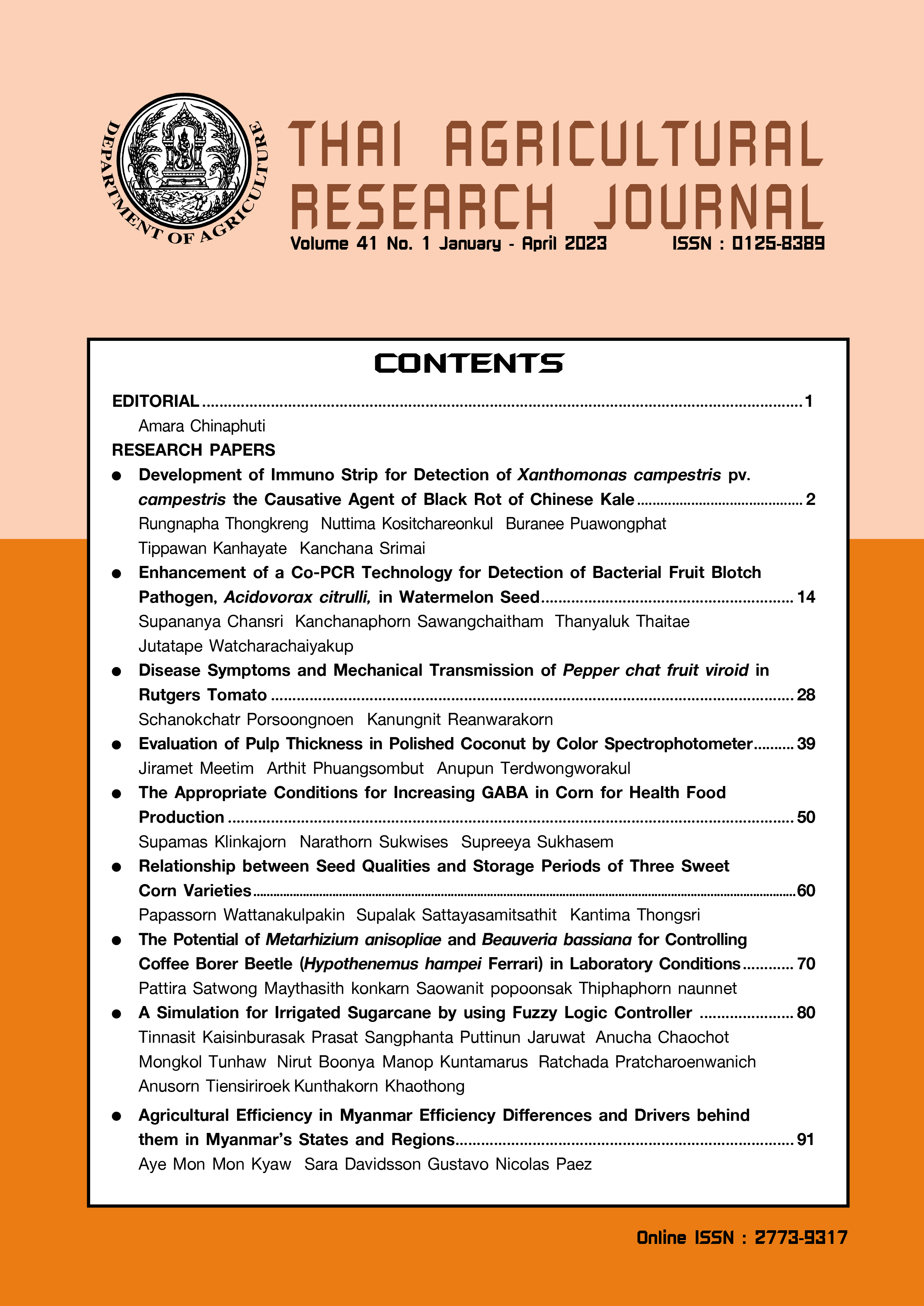The Appropriate Condition for Increasing GABA in Corn for Health Food Production
DOI:
https://doi.org/10.14456/thaidoa-agres.2023.5Keywords:
GABA, corn, soaking, pH, monosodium glutamateAbstract
GABA (γ-aminobutyric acid) is an amino acid that serves as the inhibitory neurotrans-mitter in the brain. It has the effect of lowering blood pressure, relieving insomnia and reducing stress. GABA could be found in germinating seeds through the activity of Glutamic Acid Decarboxylase (GAD) with glutamic acid or glutamate salt as a precursor. This research aimed to test and select the appropriate process to increase GABA content in various corn varieties using as raw material in health food products. Three recommended corn varieties of the of the Department of Agriculture were used in this experiment, i.e waxy corn var. Chainat 84-1, sweet corn var. Chainat 7566 and sweet corn var. Songkhla 1. Factors affecting the activity of GAD enzyme in GABA synthesis were studied which were the soaking period, the suitable pH and the suitable amount of monosodium glutamate for increasing GABA. Results showed that variety of corn and soaking period influenced the increase of GABA content in corn seeds. Sweet corn has higher ability to synthesize GABA than waxy corn. Moreover, longer soaking period would generate more GABA in corn seed. GABA content in corn seeds was found to be higher under low acidic condition (pH 6.5) when provided with optimum amount of GAD precursor. Results also showed that sweet corn var. Songkhla 1 has the highest ability to convert glutamic acid to GABA by GAD. The overall suitable conditions for increasing GABA was soaking corn seed for 24 hrs in pH-6.5 water adjusted by citric acid 0.1 M with the addition of 0.5% of monosodium glutamate as GAD substrate. GABA in corn seeds would increase to 259.2 mg/100 g or 1,006 which was.75% higher than the initial GABA content in seeds at 23.42 mg/100 g, without any off-flavor taste suitable for using as raw material in the high GABA content food products.
References
กองโภชนาการ กรมอนามัย. 2544. ตารางแสดงชนิดและปริมาณกรดอมิโนในอาหารไทย กองโภชนาการ กรมอนามัย กระทรวงสาธารณสุข. 51 หน้า.
จารุรัตน์ สันเต วรนุช ศรีเจษฎารักข์ และรัชฎา ตั้งวงค์ไชย. 2550. ผลของกระบวนการแช่ต่อปริมาณสารแกมมาอะมิโนบิวทาริกแอชิดในข้าวกล้องงอก (หอมมะลิ 105). ว.วิทย์.กษ. 38(5) (พิเศษ): 164-167.
ณัฐฌา เหล่ากุลดิลก สุวนันท์ คำปัน ธัญเรศ พรมอินทร์ นภาพันธ์ โชคอำนวยพร และนันทินา ดำรงวัฒนกูล. 2561. สภาวะที่เหมาะสมสำหรับการงอกของข้าวเหนียวพันธุ์ กข6 และการประยุกต์ใช้ในผลิตภัณฑ์ข้าวอบพอง. วารสารเกษตร. 34(2): 297-309.
ยุพกนิษฐ์ พ่วงวีระกุล และวาสนา กล้าหาญ. 2553. การเปลี่ยนแปลงปริมาณวิตามินบี 1 และแกมมาแอมิโนบิวทิริกแอซิดในการผลิตข้าวงอกนึ่งขาวดอกมะลิ 105 ระดับโรงงานต้นแบบ. เรื่องเต็มการประชุมทางวิชาการของมหาวิทยาลัยเกษตรศาสตร์ ครั้งที่ 48: สาขาอุตสาหกรรมเกษตร. กรุงเทพฯ: มหาวิทยาลัยเกษตรศาสตร์.
วัฒนา วัชรอาภาไพบูลย์ ณัฏฐ เลาหกุลจิตต์ อรพิน กิดชูชื่น และทรงศิลปี พจน์ชนะชัย. 2550. ผลของพีเอช อุณหภูมิ และเวลาการแซ่ข้าวต่อคุณภาพของข้าวกล้องงอก. ว.วิทย์.กษ. 38(6)(พิเศษ): 169-172.
สุนัน ปานสาคร และ จตุรงค์ ลังกาพินธุ์. 2556. พัฒนากระบวนการผลิตผลิตภัณฑ์งางอกร่วมกับการคั่ว เพื่อการเพิ่มมูลค่าผลผลิตทางการเกษตร. แก่นเกษตร. 41(3): 305-316.
สำนักงานเศรษฐกิจการเกษตร. 2563. ข้าวโพดหวาน: เนื้อที่เพาะปลูก เก็บเกี่ยว ผลผลิต และผลผลิตต่อไร่ รวมทั้งประเทศ ปี 2562. แหล่งข้อมูล http://www.oae.go.th/view/1/ตารางแสดงรายละเอียดข้าวโพดหวาน/TH-TH สืบค้น: 10 ตุลาคม 2563
อิงฟา คําแพง อรพิน เกิดชูชื่น และ ณัฏฐา เลาหกุลจิตต. 2552. การเปลี่ยนแปลงสารอาหารของขาวและธัญพืชในระหวางการงอก. ว.วิทย.กษ. 40(3)(พิเศษ): 341-344.
Bouche, N. and Fromm, H. 2004. GABA in plants: Just a metabolite. Trends in Plant Science 9(3): 110-115.
Lehninger, L., Nelson, L. and Cox, M. 1993. Principles of Biochemistry. 2nd edition. New York, worth publisher. pp. 714.
Limure, T., Kihara, M., Hirota, N., Zhou, T., Hayashi, K. and Ito, K. 2008. A method for production of -aminobutyric acid (GABA) using barley bran supplemented with glutamate. Food Research International. 42(3): 319-323.
Maeda, Y., Lisi, T. L., Vance, C. G. and Sluka, K. A. 2007. Release of GABA and activation of GABA(A) in the spinal cord mediates the effects of TENS in rats. Brain research, 1136(1), 43–50.
Ohtsubo, S., Asano, S., Sato, K., and Matsumato, I. 2000. Enzymatic production of -aminobutyric acid using rice (Oryza sativa) Germ. Food sci. Technol Res. 6(3): 208-211.
Okada, T., Sugishita, T. Murakami. T., Murai, H., Saikusa, T., Horino, T., Onoda, A., Kajimoto, O., Takahashi, R. and Takahashi, T. 2000. Effect of the defatted rice germ enriched with GABA for sleeplessness, depression, autonomic Disorder by oral administration. Nippon Shokuhin Kagaku Kogaku Kaishi. 47:596-603.
Petritis, K., Elfakir. C. and Dreux, M. 2002. A comparative study of liquid chromatographic detectors for the analysis of underivatized amino acids. Journal of chromatography. A. 961(1): 9-21.
Polthum, P. and Ahromrit A. 2014. GABA content and Antioxidant activity of Thai waxy corn seeds germinated by hypoxia method. Songklanakarin J. Sci. Technol. 36 (3), 309-316.
Powers, M.E., Yarrow, J.F., McCoy, S.C. and Borst, S.E. 2008. Growth hormone isoform responses to GABA ingestion at rest and after exercise. Medicine and Science in Sports and Exercise. 40(1): 104–110.
Saikusa, T., Horino, T. and Mori, Y. 1994. Distribution of free amino acids in the rice kernel and kernel fractions and the effect of water soaking on the distribution. Journal of Agricultural and Food Chemistry. 42(5): 1122-1125.
Satyanarayan, V. and Nair, P.M. 1985. Purification and characterization of glutamate decarboxylase from Solanum tuberosum. European Journal of Biochemistry. 150(1): 53-60.
Schousboe, A. and Waagepetersen, H.S. 2007. GABA: homeostatic and pharmacological aspects. Progress in Brain Research. 160: 9–19.
Shelp, B.J., Bown, A.W. and McLean, M.D. 1999. Metabolism and functions of gamma-aminobutyric acid. Trends in Plant Science. 4(11): 446-452.
Varanyanond W., Tungtrakul, P., Surojanametakul, V., Watanasiritham, L. abd Luxiang, W. 2005. Effects of water soaking on -aminobutyric acid (GABA) in germ of different Thai rice varieties. Kasetsart J. (Nat. Sci.) 411-415.
Vermulapalli, S. and Barletta, M. 1984. The role of the sympathetic nervous system in the cardiovascular effects of systemically administered -aminobutyric acid. Arch. Int. Pharmacodyn. 267:46-58.
Downloads
Published
How to Cite
Issue
Section
License
Copyright (c) 2023 Thai Agricultural Research Journal

This work is licensed under a Creative Commons Attribution-NonCommercial-NoDerivatives 4.0 International License.
Thai Agricultural Research Journal



